
Two NIGMS-funded programs are teaming up to shape the future of science and technology in West Virginia (WV). One engages high school students in science, technology, engineering, math, and medicine (STEM+M); introduces them to research; and provides direct access to college through tuition waivers. In the other program, undergraduate students are paired with a researcher at their institution for a paid internship—an important step toward a career in science.
The Health Sciences & Technology Academy
“We liken our students to rosebuds. As they grow, you see them blossom into self-confident leaders,” says Catherine Morton, Ed.D., director of the Health Sciences & Technology Academy (HSTA) in West Virginia. This mentoring program is supported in part by an NIGMS Science Education Partnership Award (SEPA).
HSTA’s goal is to increase the number of underserved students who enter and succeed in undergraduate and graduate degree programs in STEM+M fields. To accomplish this, HSTA runs summer camps and after-school clubs for high school students that focus on science, math, research, and leadership.
The Summer Institute, HSTA’s series of free summer camps, is held at universities across the state. Freshmen, sophomores, and juniors spend 1 week learning about community-based research, steps to design a research project, and health-related subjects like anatomy or public health. Seniors attend a 3-week camp focused on various topics, such as improving math skills or learning about the role government plays in research, all while preparing for college.

HSTA after-school clubs meet at high schools in 27 of West Virginia’s 55 counties. Through these clubs, students learn skills in observation, hypothesis formation, experimentation, analysis, and communication. They also lead a community-based research project of their choice, which culminates in a presentation at an annual symposium open to family and friends. Freshmen and sophomores conduct wellness surveys that gather and report data on topics such as reliable cell phone service and access to clean water or grocery stores. Juniors and seniors lead educational interventions aimed at informing members of their communities about some of the health challenges they face, including tobacco-related illnesses, diabetes, and heart disease.
“The key part of these research projects is making the connection between science and community wellness,” explains Summer Kuhn,
M.S., a community research associate with HSTA and former HSTA scholar herself. “Students are learning and making discoveries and then passing on that knowledge to their families.” Kuhn’s sentiments reinforce Dr. Morton’s analogy that passing on knowledge helps the rest of the rosebuds on the rosebush blossom.
Students who participate in a set number of HSTA activities and meet other requirements are eligible to receive a tuition waiver to any West Virginia state college. “The tuition waiver is good for 10 years. It covers undergraduate, master’s, and doctorate degrees,” says Kuhn. She used the waiver to earn her bachelor’s and master’s degrees and is now enrolled part-time in a sociology Ph.D. program at West Virginia University (WVU) in Morgantown while working for HSTA.
With the HSTA waiver, many students can pursue higher education when they otherwise wouldn’t be able to due to financial barriers.
IDeA (Institutional Development Award) Networks of Biomedical Research Excellence
The IDeA Networks of Biomedical Research Excellence (INBRE) program in West Virginia, called WV-INBRE, provides undergraduate students with research opportunities at several universities across the state. The WV-INBRE summer research program places students from primarily undergraduate institutions at WVU and Marshall University in Huntington for 9-week paid internships. During the program, students work on biomedical research projects alongside peer mentors. At the end of their internships, students present their projects at an annual summer research symposium.
Two Programs, One Goal
Over time, the HSTA and WV-INBRE leaders recognized their shared role in training the state’s future science and technology workforce and began to collaborate. Now, HSTA scholars who enroll at institutions in the WV-INBRE network are eligible for paid internships during the school year in research labs on campus, which WV-INBRE helps them connect with. Students present their research projects at the summer symposium alongside the summer interns. In addition, high school teachers from HSTA schools are eligible to participate in the summer internship program. Afterward, many apply what they learned through their research to designing new curricula for their students, changing how science is taught in high schools across West Virginia.

“We decided to find ways that WV-INBRE investigators, leaders, and students from around the state could impact HSTA clubs and activities in a positive way,” says Gary Rankin, Ph.D., the principal investigator for WV-INBRE. With help from Valerie Watson, M.S., the coordinator for the partnership, WV-INBRE mentors and interns visit HSTA after-school clubs to talk about the WV-INBRE program and what it offers, and even serve as judges during the annual HSTA symposium.
To date, nearly 3,500 West Virginia high school students have earned HSTA tuition waivers, and 87 percent of them went on to graduate from college, far surpassing state and national averages. By empowering these hardworking trainees, HSTA and WV-INBRE are paving the way to a bright future for STEM+M in West Virginia. NIGMS recently funded a Small Business Innovation Research (SBIR) grant to replicate this success in other states. Applying this collaborative model between NIH-funded programs across the country could further broaden participation in the biomedical research workforce.
Seeing the Success

The careers of past scholars showcase how life-changing HSTA and WV-INBRE can be. Jesse Hall, Ph.D., applied to HSTA because he’d been curious about the world and how it works since he was a child. He never believed he’d go to college, but earning a tuition waiver through HSTA made it possible.
Dr. Hall studied biology at West Liberty University in West Liberty, West Virginia, and received WV-INBRE funding during that time to perform research under the mentorship of Joseph Horzempa, Ph.D. He then pursued a Ph.D. in immunology and microbiology at WVU in the lab of Heath Damron, Ph.D. Now, Dr. Hall is a postdoctoral researcher at Ohio State University in Columbus studying vaccines against respiratory pathogens.
“HSTA and WV-INBRE support was a blessing,” Dr. Hall says. “The programs gave me a sense of belonging and an avenue to better myself through education. They give people like me, first-generation college graduates, a chance to pursue a career in science and make an impact in our communities.”
HSTA is supported by the SEPA program through grant R25GM146285. WV-INBRE is supported by the NIGMS INBRE program through grant P20GM103434. The SBIR program (briefly mentioned above) supports grant R43GM149014.







